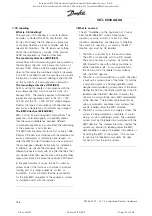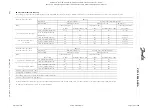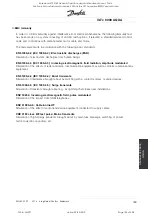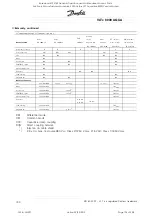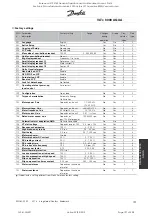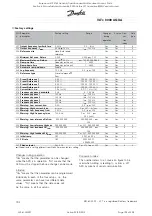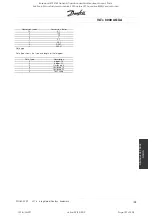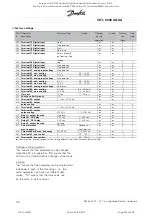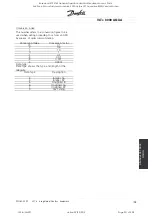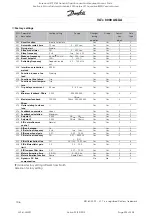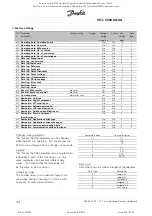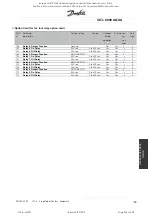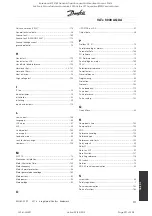
VLT
®
8000 AQUA
■
CE labelling
What is CE labelling?
The purpose of CE labelling is to avoid technical
obstacles to trade within EFTA and the EU. The
EU has introduced the CE label as a simple way
of showing whether a product complies with the
relevant EU directives. The CE label says nothing
about the specifications or quality of the product.
AFDS are regulated by three EU directives:
The machinery directive (98/37/EEC)
All machines with critical moving parts are covered by
the machinery directive, which came into force on 1
January 1995. Since an AFD is largely electrical, it
does not fall under the machinery directive. However,
if an AFD is supplied for use in a machine, we provide
information on safety aspects relating to the AFD. We
do this by means of a manufacturer
’
s declaration.
The low-voltage directive (73/23/EEC)
AFDs must be CE labelled in accordance with the
low-voltage directive, which came into force on 1
January 1997. The directive applies to all electrical
equipment and appliances used in the 50 - 1000
Volt AC and the 75 - 1500 Volt DC voltage ranges.
Danfoss CE labels in accordance with the directive
and issues a declaration of conformity upon request.
The EMC directive (89/336/EEC)
EMC is short for electromagnetic compatibility. The
presence of electromagnetic compatibility means
that the mutual interference between different
components/appliances is so small that the functioning
of the appliances is not affected.
The EMC directive came into force on 1 January 1996.
Danfoss CE labels in accordance with the directive and
issues a declaration of conformity upon request. In
order that EMC-correct installation can be carried out,
this manual gives detailed instructions for installation.
In addition, we specify the standards which our
different products comply with. We offer the filters that
can be seen from the specifications and provide other
types of assistance to ensure the optimum EMC result.
In the great majority of cases, the AFD is used by
professionals of the trade as a complex component
forming part of a larger appliance, system or
installation. It must be noted that the responsibility
for the final EMC properties of the appliance, system
or installation rests with the installer.
■
What is covered
The EU "Guidelines on the Application of Council
Directive 89/336/EEC" outline three typical
situations of using an AFD. For each of these
situations, explanations are offered as to whether
the situation in question is covered by the EMC
directive and must be CE labelled.
1. The AFD is sold directly to the end-consumer.
The AFD is for example sold to a DIY market.
The end-consumer is a layman. He installs the
AFD himself for use with a hobby machine, a
kitchen appliance, etc. For such applications,
the AFD must be CE labelled in accordance
with the EMC directive.
2. The AFD is sold for installation in a plant. The plant
is built up by professionals of the trade. It could be
a production plant or a heating/ventilation plant
designed and installed by professionals of the trade.
Neither the AFD nor the finished plant has to be CE
labelled under the EMC directive. However, the
unit must comply with the basic EMC requirements
of the directive. The installer can ensure this by
using components, appliances and systems that
are CE labelled under the EMC directive.
3. The AFD is sold as part of a complete system. The
system is being marketed as complete. It could
be e.g. an air-conditioning system. The complete
system must be CE labelled in accordance with the
EMC directive. The manufacturer who supplies the
system can ensure CE labelling under the EMC
directive either by using CE labelled components or
by testing the EMC of the system. If he chooses
to use only CE labelled components, he does
not have to test the entire system.
MG.80.A7.22 - VLT is a registered Danfoss trademark
186
Rosewood STP ST42 General (Operation and Maintenance Manual - Part 4:
Section 6.3 Manufacturers Manuals 6.3.33 Danfoss VLT Aquadrive 8000) Vendor Manual
QP Id: VM207
Active: 03/09/2013
Page 192 of 208















